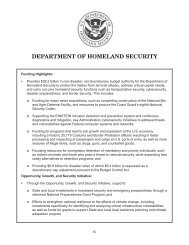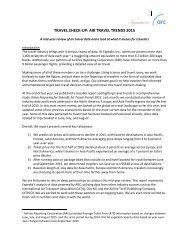A-HRC-13-42
Create successful ePaper yourself
Turn your PDF publications into a flip-book with our unique Google optimized e-Paper software.
A/<strong>HRC</strong>/<strong>13</strong>/<strong>42</strong><br />
page 26<br />
Court further developed its view in its advisory opinion on the Legal Consequences of the<br />
Construction of a Wall in the Occupied Palestinian Territories:<br />
The protection offered by human rights conventions does not cease in case of armed<br />
conflict, save through the effect of provisions for derogation of the kind to be found in<br />
article 4 of the [International Covenant on Civil and Political Rights]. As regards the<br />
relationship between international humanitarian law and human rights law, there are thus<br />
three possible situations: some rights may be exclusively matters of international<br />
humanitarian law; others may be exclusively matters of human rights law; yet others may<br />
be matters of both these branches of international law. 56<br />
53. In its judgement in the Case concerning Armed Activities on the Territory of the Congo<br />
(Democratic Republic of the Congo v. Uganda), the Court already applied international<br />
humanitarian law and international human rights law in parallel, without as a first step<br />
identifying the lex specialis or the exclusive matter. 57 In their report on the mission to Lebanon<br />
and Israel from 7 to 14 September 2006, the Special Rapporteur on extrajudicial, summary or<br />
arbitrary executions, the Special Rapporteur on the right of everyone to the enjoyment of the<br />
highest attainable standard of physical and mental health, the Representative of the<br />
Secretary-General on the human rights of internally displaced persons and the Special<br />
Rapporteur on adequate housing as a component of the right to an adequate standard of living<br />
stated that human rights law and international humanitarian law were not mutually exclusive, but<br />
existed in a complementary relationship during armed conflict; a full legal analysis required<br />
consideration of both bodies of law. In respect of certain human rights, more specific rules of<br />
international humanitarian law might be relevant for the purposes of their interpretation. 58 A<br />
complementary approach forming the basis of the present study is also supported by the principle<br />
of systemic integration contained in article 31, paragraph 3 (c), of the Vienna Convention on the<br />
Law of Treaties, which provides that, in interpreting an international treaty there shall be taken<br />
into account, together with the context … any relevant rules of international law applicable in the<br />
relations between the parties [of the treaty].” 59<br />
stated that in the case of a conflict between the provisions of the two legal regimes [international<br />
humanitarian law and international human rights law] with regard to a specific situation, the lex<br />
specialis will have to be identified and applied.<br />
56 I.C.J. Reports 2004 (9 July 2004), para. 106.<br />
57 I.C.J. Reports 2005, p.168, para. 216 et seq.<br />
58 A/<strong>HRC</strong>/2/7, para. 16.<br />
59 Report of the study group of the International Law Commission entitled “Fragmentation of<br />
international law: difficulties arising from the diversification and expansion of international law”<br />
(A/CN.4/L.682/Add.1), para. 17 et seq.
















